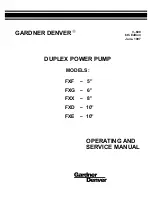
16
discharge valve assembly and fill the reagent head as described in Step (3) above.
The pump will now self-prime when started up per step (4) above.
6.3 Calibration
Figure 14
All metering pumps must be calibrated in order to accurately specify stroke length
settings for required flow rates. For pumps provided with DLC/M electronic controls,
refer to separate instructions provided with those controllers.
A typical calibration chart is shown in Figure 14. Although output is linear with respect to
stroke length setting, an increase in discharge pressure decreases output uniformly,
describing a series of parallel lines, one for each pressure (only two are shown).
The theoretical output flow rate at atmospheric discharge pressure is based on the
displacement of the diaphragm, stroke length and the stroking rate of the pump. With
increasing discharge pressure there is a some corresponding decrease in output flow.
Pumps are rated at a certain flow at their rated pressure (check nameplate). Whenever
possible, calibration should be performed under actual process conditions (i.e., the same
or a similar process liquid at system operating pressure).
To construct a calibration chart, measure the flow rate several times at three or more
stroke settings (i.e., 25, 50, 75, and 100), plot these values on linear graph paper, and
draw a best-fit line through the points. For stable conditions, this line should predict
settings to attain required outputs.
















































